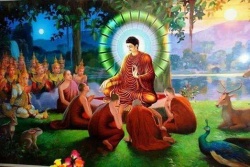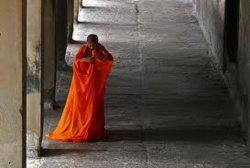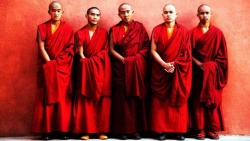Blue
Blue is a color, the perception of which is evoked by light having a spectrum dominated by energy with a wavelength of roughly 440-490 nm. It is considered one of the additive primary colors.
On the HSV Color Wheel, the complement of blue is yellow; that is, a color corresponding to an equal mixture of red and green light. On a color wheel based on traditional color theory (RYB), the complementary color to blue is considered to be orange (based on the Munsell color wheel).
The English language commonly uses "blue" to refer to any color from navy blue to cyan. The word itself is derived from the Old French word bleu.
A Scots and Scottish English word for "blue-grey" is blae, from the Middle English bla ("dark blue," from the Old English blood). Ancient Greek lacked a word for color blue and Homer called the color of the sea "wine dark", except that the word kyanos (cyan) was used for dark blue enamel.
In the English language, blue may refer to the feeling of sadness. This is because blue was related to rain, or storms, and in Greek mythology, the god Zeus would make rain when he was sad (crying), and a storm when he was angry.
Kyanos was a name used in Ancient Greek to refer to dark blue tile (in English it means blue-green or cyan). The phrase "feeling blue" is linked also to a custom among many old deepwater sailing ships. If the ship lost the captain or any of the officers during its voyage, she would fly blue flags and have a blue band painted along her entire hull when returning to home port.
Many languages do not have separate terms for blue and or green, instead using a cover term for both (when the issue is discussed in linguistics, this cover term is sometimes called grue in English). Blue is commonly used on internet browsers to color a link that has not been clicked; when a link has been clicked it changes yellow or orange or purple.
Blue is the color of truth, serenity and harmony, by helping to soothe the mind. It is good for cooling, calming, reconstructing and protecting. good for fevers, calming the body and mind, raising frequency, etc.
Blue is the color of electricity. We experience in a program created by electromagnetic energy that had a beginning and is evolving out of physical consciousness.
Blue connects with the third eye chakra.
Blue relates to the future in linear time as it is a faster moving frequency than we experience in the physical. Consciousness is moving into the blue. (Midnight) Blue takes us to 12:00, 12 around 1 creational geometry, 2012 Mayan Calendar Prophecy, Hopi Blue Kachina Prophecies, Isis/Sirius, and more.
Egyptian Blue is one of the first artificial pigments known to have been used by man. First created around 5,000 years ago by heating a mixture of a calcium compound, a copper-containing compound, silica sand and soda or potash to around 850-950 C, the precious pigment was reserved for the most exquisite of artworks. In Egyptian belief, blue was considered the color of the heavens, and hence the universe. It was also associated with water and the Nile. However, scientists have now found traces of the rare pigment behind drab-colored mummy portraits, leading to a new understanding of how this particular pigment was used by artists in the second century A.D.
Dusting off 15 Roman-era Egyptian mummy portraits - mostly untouched for 100 years - has revealed a 2,000-year-old surprise. Researchers discovered that the ancient artists used the pigment Egyptian blue as material for under drawings and for modulating color -a finding never documented before. Because blue has to be manufactured, it typically is reserved for very prominent uses, not hidden under other colors. We see how these artists manipulated a small palette of pigments, including this unusual use of Egyptian blue, to create a much broader spectrum of hues.
Blue pigments of the past have often been expensive (ultramarine blue was made from the gemstone lapis lazuli, ground up), poisonous (cobalt blue is a possible carcinogen and Prussian blue, another well-known pigment, can leach cyanide) or apt to fade (many of the organic ones fall apart when exposed to acid or heat). So it was a pleasant surprise to chemists at Oregon State University when they created a new, durable and brilliantly blue pigment by accident.
Despite the color's gloomy connotations, exposure to blue light can increase confidence and boost happiness levels, research suggests. Researchers exposed a group of volunteers to a range of colors and lights. They found that blue and green made male subjects feel happier, while blue, purple and orange did the same for women.
Source
http://www.crystalinks.com/colors.html
Nila Bold text


